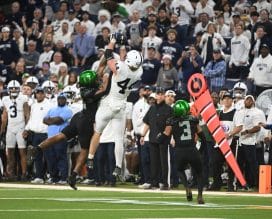Flyers
Flyers 5: Takeaways from Thursday’s Flyers-Canadiens Game
By Kevin Durso, Sports Talk Philly editor
Coming off a 6-1 win that brought a lot of good vibes, the situation seemed right for the Flyers to continue their winning streak. The Montreal Canadiens entered the game with six wins on the season. They were on a seven-game losing streak of their own, battered by injuries.
If the Flyers were riding high from their performance on Tuesday, a similar effort could have made this a walk in the park. Instead, the Flyers essentially took the first period off.
Even when the Flyers took the lead in the second and carried it into the later stages of the third, they couldn’t shake the Canadiens. Montreal managed to get it tied with under six minutes to go, then got the game to a shootout, where the Flyers' struggles continued.
It makes the performance on Tuesday more of an anomaly. It kills the momentum that this streak was building. It doesn’t help create more of an identity for a team that desperately needs one. So you can throw the positives and good vibes out the window.
Here are five takeaways from Thursday’s 3-2 shootout loss.
1. Sleepy Start
To start the game, the Flyers had a handful of shifts that resembled the team from Tuesday’s game. They appeared to be engaged and willing to go to the net to make the night difficult for Cayden Primeau, in just his ninth career NHL start.
Then Zack MacEwen took an interference penalty, and from that point, the Flyers were on their heels.
The Canadiens didn’t score on the man-advantage, but did seconds after it expired as Brett Kulak’s shot was deflected by Artturi Lehkonen. That proved to be the only goal, and it could have been way worse.
The Canadiens out-shot the Flyers in the first period, 19-8. At 5-on-5, they led in shot attempts, 17-10. They led in scoring chances, 14-5. They dominated in high-danger scoring chances, 10-0. The Canadiens were so in control that their expected goals for in the first period at 5-on-5 was 1.48. The Flyers finished at 1.53 expected goals for…for the game at 5-on-5.
The Flyers couldn’t generate anything. They had no rhythm. Their puck management was pathetic – how does seven giveaways in the first 10 minutes of the game sound? It was the same classic formula of showing up late and hoping and praying your goaltender keeps you in it. Spoiler alert: he did.
This was not the way to start against the 31st-ranked team in the NHL. It later proved costly to the Flyers. Sure, they got the lead, but the law of averages eventually caught up and the game was tied in the period where the Flyers actually played their best.
2. Caught Stealing
The only reason this was still a game through 20 minutes was because of Carter Hart. He was up to 18 saves in the first period, many of them desperation saves with the puck right along the blue paint.
After getting the lead in the second, Hart was up to 29 saves on 30 shots through two periods. Shot volume was more limited in the third, but with under seven minutes to play, Hart was up to 35 saves on the night. He made a 36th save before the rebound on the 38th shot he faced managed to get through and tie the game.
Make no mistake about it, Hart once again did his part. He finished the night with 38 saves total, and unlike the previous two shootouts the Flyers were in, he got the benefit of a miss high over the net and made a pad save to keep the Flyers within reach to the final shooter. He deserved a much-better fate, probably the only Flyer that deserved the win. It just wasn’t meant to be.
3. Missed OT Opportunity
Late in the third period, the Flyers were really buzzing and had the potential to maybe still escape with the win in regulation. Knowing their struggles in shootouts, the Flyers golden opportunity came in the form of a power play 44 seconds into overtime.
Facing a team with the 29th-ranked penalty kill, this was the Flyers chance. Despite entering the game ranked 27th in power play in the league, the Flyers had also had just one man-advantage since the start of the third period of their game in Arizona last Saturday, so it had been limited action and allowed the rankings to become a bit skewed.
Nonetheless, the Flyers had a chance and didn’t really push the play. Most of their setup was kept to the outside and if they did seem to get into space for a potential shot, they either couldn’t control the puck or flubbed the shot attempt.
Win or lose, the start of these takeaways would still have been about the Flyers no-show first period and getting locked into a battle with the league’s 31st-ranked team after at least winning in easier fashion in Arizona on Saturday and dominating the Devils earlier in the week. If they would have pulled out the win, even in this spot in OT, for as ugly as it would have been, it still would have been the desired and expected result. This was their opportunity, and it went by the wayside.
4. Unlikely Scoring Sources
To give you an idea of how things are going for the Canadiens, they were 5:39 away from losing a game to the Lehigh Valley Phantoms.
No, the Flyers did not have the shorthanded lineup that Montreal was dealing with, but their scoring in the second period came from some rather unlikely sources, who just weeks earlier were trying to put up offense at the AHL level.
First, Max Willman continued a string of strong games since his return to the Flyers. For the third time in the last four games, Willman picked up a point, this time getting his second NHL goal to tie things up. After Tuesday’s game, interim head coach Mike Yeo said that Willman was “showing me something.” Sure seems like that continued in this game.
Then came the go-ahead goal with exactly one minute left in the second. A little touch pass by Patrick Brown sent Jackson Cates in on a two-on-one. He kept it himself and went five-hole, beating Primeau to give the Flyers the lead with his first NHL goal.
5. An Empty Building
Well, it’s been no secret what the NHL and the other professional sports leagues have been dealing with lately. A rise in COVID cases across the US and Canada have forced some changes.
In the NHL, it started with an adjustment in protocols. Back to daily testing except on complete off days, back to regular masking, back to staying out of the public eye as much as possible, enforced until at least Jan. 7 when the NHL and NHLPA will re-evaluate. But Thursday’s game in Montreal brought back a sight that none of us wanted to see nor expected to see at this time.
About two hours prior to the game between the Flyers and Canadiens, a statement was released by the Canadiens acknowledging a request from the Quebec public health officials to play in front of no fans, essentially returning to the empty buildings of the bubble.
Obviously, all things are subject to change. Certain protocols are also subject to be added or altered due to location. It’s no secret the restrictions Canada has implemented during the pandemic, which kept arenas unoccupied by fans for months after the US arenas starting welcoming patrons back and were still at limited capacity in the Stanley Cup Final. But obviously, this is also a sign that things are far from over in regards to COVID-19.
The Calgary Flames have 18 players in protocol. The Nashville Predators have six. The Carolina Hurricanes have six. The Vancouver Canucks have four. The Boston Bruins are up to six. The Florida Panthers, Colorado Avalanche, Hurricanes, and Predators were all facing the possibility of playing with shorthanded rosters due to salary cap constraints amid COVID outbreaks. The overall total of players in COVID protocol in the last four days is over 60, rapidly nearing 10 percent of the players actively available on NHL rosters (assuming all 32 NHL rosters are maxed out at 23 players, which would make the total number of players in the league 736), with the current rate just under nine percent at the moment.
The Olympics are severely in question at this point. There are doubts if the league can move forward without doing something to stop play for a period to allow for more players to exit protocol. Even if they did pause the season to some extent, it seems it would only be delaying the inevitable. This is spreading like wildfire.
To this point, the Flyers only have one player in COVID protocol. Morgan Frost was removed from Tuesday’s game and not available for the team’s road trip to Montreal. The good news for the Flyers on this front is that they were able to avoid a situation that Carolina faced earlier this week. Carolina had two players and a staff member test positive in Vancouver and faced a 14-day quarantine there, but the Hurricanes were able to return those people to the US by chartering a private plane.
The Flyers were able to return home on Thursday night and to this point have had no additional players or staffers enter protocol outside of Frost. They don’t go north of the border again until March 18 when they face the Ottawa Senators. In fact, outside of that trip to Ottawa, they have just two more trips to Canada beyond that in the season, both in the final two weeks of April, so that is far down the line at this point.
Even if the Flyers had won this game convincingly and kept the good vibes going, it’s hard to stay positive when the rest of the hockey world is dealing with this in mass. It’s hard to see the light at the end of the tunnel when more and more players are entering protocol with no end in sight. Specifically in the Flyers case, the Devils had another player enter protocol on Thursday after playing in Philadelphia on Tuesday. The Coyotes also had two players enter protocol with possibly more on the way. The Flyers were just in town last Saturday. So the Flyers are far from being out of the woods, and that’s something to monitor in the next few days, especially as this surge in cases continues.





